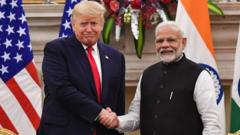The new deal is expected to shape trade dynamics between the U.S., Vietnam, and China, especially as it addresses concerns over tariff evasion routes.
Trump Reveals Initial Trade Agreement with Vietnam to Adjust Tariffs

Trump Reveals Initial Trade Agreement with Vietnam to Adjust Tariffs
The president announced a preliminary trade pact with Vietnam aimed at reducing tariffs while promoting American goods.
President Trump announced on Wednesday a significant trade agreement with Vietnam, marking a pivotal moment in U.S. trade policy. The deal aims to roll back some of the stringent tariffs previously enforced on Vietnamese imports in return for Vietnam's commitment to lower barriers for American products in its markets.
The preliminary terms of this trade pact come at a time when U.S. imports from Vietnam have surged, partly due to manufacturers relocating operations away from China in response to Trump's earlier tariffs imposed on Chinese goods. The new agreement establishes a 20 percent tariff on all products imported from Vietnam, while a more drastic 40 percent tariff will be levied on goods identified as “transshipping,” aimed at preventing Vietnamese channels from serving as an avenue for Chinese goods to evade American tariffs.
Specifics regarding which products will incur the higher tariff remain vague. The classification could involve goods exported to the U.S. from Vietnam that are primarily manufactured in China, or Vietnamese items that incorporate significant Chinese components. The agreement might also outline a tiered tariff approach to further promote Vietnamese goods with lower Chinese content or materials.
Howard Lutnick, the Commerce Secretary, emphasized on X that any attempt for foreign countries to sell products through Vietnamese exports will face the steep 40 percent tariff. As trade relations evolve, this arrangement signals a complex shift in how the U.S. interacts with both Vietnam and China, examining the intricate web of global trade dynamics.
As the agreement develops, its implications for broader trade practices will be closely monitored, particularly in how they affect economic exchanges within the region and the U.S.'s strategies concerning its main trading partners.
The preliminary terms of this trade pact come at a time when U.S. imports from Vietnam have surged, partly due to manufacturers relocating operations away from China in response to Trump's earlier tariffs imposed on Chinese goods. The new agreement establishes a 20 percent tariff on all products imported from Vietnam, while a more drastic 40 percent tariff will be levied on goods identified as “transshipping,” aimed at preventing Vietnamese channels from serving as an avenue for Chinese goods to evade American tariffs.
Specifics regarding which products will incur the higher tariff remain vague. The classification could involve goods exported to the U.S. from Vietnam that are primarily manufactured in China, or Vietnamese items that incorporate significant Chinese components. The agreement might also outline a tiered tariff approach to further promote Vietnamese goods with lower Chinese content or materials.
Howard Lutnick, the Commerce Secretary, emphasized on X that any attempt for foreign countries to sell products through Vietnamese exports will face the steep 40 percent tariff. As trade relations evolve, this arrangement signals a complex shift in how the U.S. interacts with both Vietnam and China, examining the intricate web of global trade dynamics.
As the agreement develops, its implications for broader trade practices will be closely monitored, particularly in how they affect economic exchanges within the region and the U.S.'s strategies concerning its main trading partners.





















